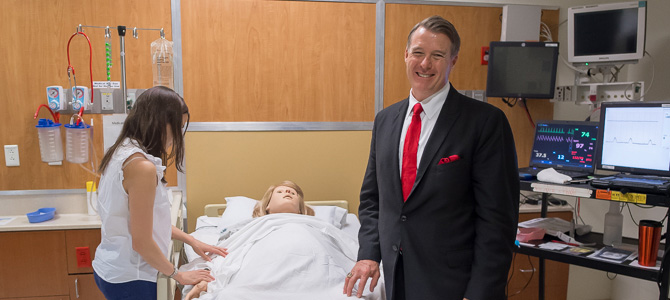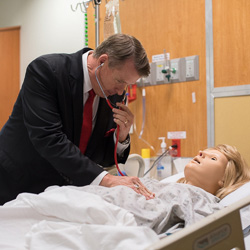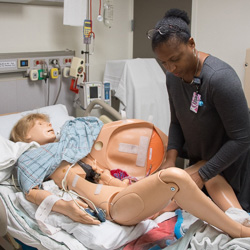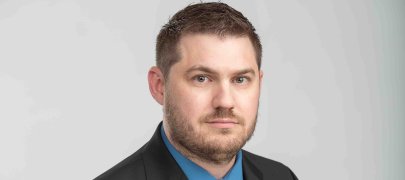
Critical Care Conference Takes Integrated, Hands-On Approach to Learning

Approximately 830 women throughout the world die from preventable causes related to pregnancy and childbirth every day.
Health care providers are attempting to change this by putting the “M” back into maternal fetal medicine, meaning a larger emphasis on the quality of care for the mother.

“The maternal mortality rate in the U.S. has been climbing over the last 10 years,” said Michael Foley, MD, chair of the conference and chairman of the Department of Obstetrics and Gynecology at the University of Arizona College of Medicine – Phoenix and Banner Health. “Because of this increase in the maternal mortality rate, practitioners need to learn how to manage these previously not encountered types of diseases and learn how to manage the increasing prevalence of diseases among advanced maternal age mothers.”
More than 400 people from throughout the world participated in the Critical Care in Obstetrics Conference Nov. 2-4 in an effort to learn a new set of skills that could potentially reduce the maternal mortality rate globally. The conference was sponsored by Banner – University Medical Center Phoenix and the Society for Maternal-Fetal Medicine.
“People think about the fetus, but don’t realize how important it is to also take care of the mother,” said Dena Goffman, MD, chief of Obstetrics and associate chief quality officer at Columbia University Medical Center. “We need to make sure we are able to take care of the unpredictable, which could be dangerous to the mother’s health.”
Dr. Goffman and Shad Deering, MD, helped Dr. Foley create the program in an effort to improve care for women around the world.
“This is a three-day event where we teach a variety of practitioners how to manage critical care scenarios that come up for pregnant women,” Dr. Goffman said. “We do a combination of lectures, skills and most excitingly, we do work here with Banner Health’s simulation center where we have teams practice various things that are involved when caring for critical care pregnant patients.”
This is the conference’s fourth year, which covers 18 topics in clinical care and obstetrics. Lectures were made available via the Internet to participants before they arrived with the expectation that they would review the material, simulations and take the exams beforehand. When they arrived for the conference, the first half-day was spent with interactive didactics that reviewed online lectures and case studies.
Participants then spent the afternoon doing one of three activities. They went to Banner Health’s Simulation Lab in Mesa where they participated in two simulations and cared for realistic mannequins. The next day, they went to skills training, which is a hands-on, one-on-one training with experts where they learned to place a breathing tube, properly bag ventilate and place a specialized IV. Lastly, participants used virtual reality to see what was happening in an OR with a peri-mortem cesarean delivery and then did a simulation in a mini-OR. They also learned how to perform basic life support.
Dr. Deering, professor and chair of the Department of OB/GYN at the Uniformed Services University of Health Sciences in Bethesda, Maryland, said the U.S. Department of Defense performs more than 45,000 deliveries each year in 50 hospitals throughout the world. He said they are responsible for all those deliveries, which makes a conference like this important in his line of work.
 “There are very few places that could pull off something like this from the physical space, the simulation mannequins, the team and administrators. There is nothing like this that is this big,” Dr. Deering said.
“There are very few places that could pull off something like this from the physical space, the simulation mannequins, the team and administrators. There is nothing like this that is this big,” Dr. Deering said.
More than 50 facilitators and debriefers and 30 staff helped coordinate the conference.
The conference was open to Maternal Fetal Medicine physicians, practicing OB physicians, emergency room physicians, OB hospitalists, residents, medical students, fellows, high-risk OB nurses and certified nurse midwives.
Dr. Foley, who is a leading proponent of the flipped classroom model, said this was not a typical health care conference.
“This is innovative thinking about how conferences and learning should happen,” he said. “It’s really built on looking toward adult learning styles.”
He believes that education is at a crossroad, moving away from the “sage on the stage,” and focused instead on new models.
“Our millennials are bored sitting in a chair for an hour watching PowerPoints,” Dr. Foley said. “The attention span is about seven to eight minutes and then their attention goes elsewhere. Most millennials have grown up in a gaming model and most of them are really into IT. We wanted to make this as experiential as possible.”
Instead of hour-long lectures, Dr. Foley believes in providing brief lectures with specific takeaways and visuals.
“We engaged participants by teaching them through different experiences, like virtual reality, where they were submerged into this new world,” Dr. Foley said. “It’s experiential learning where they learn physically, so when it comes to patient care, they have more skills, make less mistakes and increase patient safety.”
Dr. Foley is applying similar approaches into the College of Medicine – Phoenix’s curriculum. Now, third-year students participate in Obstetrics and Gynecology emergency simulations in a flipped classroom model.
“Through these simulations we are able to work with what we call 'non-consequential learning' — no one dies,” Dr. Foley said. “These simulations teach us the consequences of decisions and how we can make those decisions better. It’s not about proving yourself; it’s about improving.”
Topics
About the College
Founded in 2007, the University of Arizona College of Medicine – Phoenix inspires and trains exemplary physicians, scientists and leaders to optimize health and health care in Arizona and beyond. By cultivating collaborative research locally and globally, the college accelerates discovery in a number of critical areas — including cancer, stroke, traumatic brain injury and cardiovascular disease. Championed as a student-centric campus, the college has graduated more than 800 physicians, all of whom received exceptional training from nine clinical partners and more than 2,700 diverse faculty members. As the anchor to the Phoenix Bioscience Core, which is projected to have an economic impact of $3.1 billion by 2025, the college prides itself on engaging with the community, fostering education, inclusion, access and advocacy.


